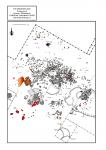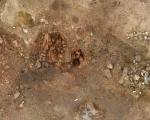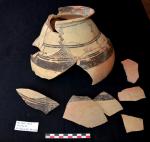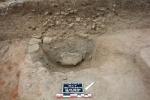Summary (English)
The 15th campaign of excavations at Incoronata continued the exploration to the north and south of the large paved terraces that extend east-west at the southern edge of the hill.
In the southern area, the excavation continued of the structures belonging to the earliest occupation phase on the site. The new materials confirmed the dating to between the late 9th and the early 8th century B.C. Surrounded to the north by the large floor US 70 and resting directly on the natural clay – which appeared to have been deliberately shaped – a complex concentration of stones (in which it at least two alignments have been identified) covered an area that has gradually been revealed to be concave. Once all the stones are removed (2018), it seems likely that a large pit excavated in the clay bank of the hill will be revealed. This feature was obliterated by a substantial deposit of deliberately broken pottery, particularly large containers, black and light brown smooth impasto, and local Iron Age pottery for ritual use including several jars with painted “curtain” decoration (fig. 1). The way in which the vases were broken and placed is of great interest as it is very similar to that documented in the ritualised closing deposits on the site, created to the north two centuries later (late 8th- early 6th century B.C.), this time using more locally produced Greek pottery.
North of the large floors, exploration continued of the area surrounding the apsed building (BTI, inside which there was evidence of Chthonic ritual practices) with the aim of understanding the nature of the activity that took place there. This sector of the hill was covered and protected by substantial layers of obliteration at the time the site was abandoned (late 7th – early 6th century B.C.) from beneath which the perfectly-preserved floor surfaces, dating to the 7th century B.C., are gradually emerging.
To the east of the apsidal building an area characterised by the presence of numerous clumps of clay heavily reddened by fire, substantial remains of carbonised timber elements, and concentrations of pottery was exposed. Most interestingly, there were two small ovoid clay structures that can be interpreted as cooking stands (30 × 40 cm and 30 × 25 cm) in a perfect state of preservation. They seemed to have been filled, at the time of their obliteration, by large fragments from the firing floor of a large kiln (fig. 2).
North of the apsed building there was a vast concentration of small cobblestones forming a surface surrounding to the north a pit (fig. 3). On top of this surface, there was a large quantity of animal bones and fragments of locally made skyphoi. The association suggests that the pit (filled and obliterated by soil, pottery and, lastly, stones) was a bothros, around which ritual activities involving eating meat and drinking wine took place.
A large pit, dug directly in natural, was situated immediately south of this context, exactly below an enormous mass of extremely compact material (stones, bricks, fragments of building materials) laid horizontally (US 428, identified last year: cf. Folder 2016, fig. 4). The fill, made up of grey soil containing almost exclusively imported Greek pottery (two fragments of Enotrian bi-chrome pottery), was sealed by stones and cobblestones. The edges of the large pit remain to be identified next season. The pit’s chronology is rather early as indicated by the terminus ante quem provided by the materials in the fill (early 7th century B.C.). The structure’s importance is indirectly suggested by the weight (material and conceptual) of the protection that was placed on top of it.
- Mario Denti- Université Rennes 2
Director
- Mario Denti, Laboratoire LAHM, UMR 6566 CReAAH, Université Rennes 2
Team
- Emmanuelle Smirou, assistant-ingénieur, Laboratoire LAHM, UMR 6566 CReAAH, Université Rennes 2
- Marine Poissenot, Université Rennes 2
- Cesare Vita, Laboratoire LAHM, UMR 6566 CReAAH, Université Rennes 2 - Università della Basilicata
- Florian Fuduche, Laboratoire LAHM, UMR 6566 CReAAH, Université Rennes 2
- Josipa Mandic, Laboratoire LAHM, UMR 6566 CReAAH, Université Rennes 2 - Università della Basilicata
- Théo Ben Makhad, Laboratoire LAHM, UMR 6566 CReAAH, Université Rennes 2
- Théo Ben Makhad, Laboratoire LAHM, UMR 6566 CReAAH, Université Rennes 2
Research Body
- Laboratoire LAHM, UMR 6566 CReAAH, Université Rennes 2
Funding Body
- Centre Jean Bérard (Napoli) - Ministère des Affaires étrangères et du Développement international (Parigi)
- Laboratoire LAHM
- Université Rennes 2






![Download [PDF]](/excavation/skins/fasti/images/results/download_sml.png)


